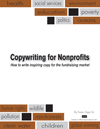Last week I attended the Bridge Conference in Washington D.C. (co-hosted by the DC chapters of AFP and DMA). The basic message was loud and clear:
Fundraising demands multiple channels
In other words, a mix of online and offline channels is essential to maximize your nonprofit’s fundraising results.
This holds true regardless of the age of your audience (i.e., donors, members, prospects, advocates, volunteers, etc.). And no matter how a donor made their first gift, when you reach out to them online AND offline . . .
• response increases
• more funds are raised
• donor life-time value goes up
• retention is improved
Good reasons to integrate. Yup; an integrated, multi-channel approach to fundraising and ALL your communications is fundamental. And I do view integration as fundamental.
The “core” channels touted by numerous presenters throughout the conference are your website, direct mail, email, and the phone (including mobile).
Certainly there are more online and offline channels. Just focus on these first for the biggest bang for your buck. Then add in other tactics and channels as your staff and budget allow.
Whatever you do, remember that a “fundamental integrated fundraising plan” won’t work unless you also incorporate the “fundamentals of good marketing.” This means that whatever tools, bells and whistles you use . . .
• make each message and web page relevant to the reader
• give readers information THEY value
• make your call-to-action crystal clear and repeat it
• write donor-centric messages and web pages
• don’t get verbose and complicated
• use a friendly, warm, and conversational style
• think about what THEY – your supporters – want and need to know
Stick to the fundamentals for better fundraising.

{ 2 trackbacks }
{ 2 comments… read them below or add one }
Karen, you are absolutely right. I went to the bridge conference and got the message also. Multi channel got preached over and over again as the cure for whatever ails you! As a provider of direct mail renewal packages and highly personalized house file mailers, I was a little depressed to see so little emphasis on direct mail, but I think that the industry is going through a “phase” where social media gets the headlines and all the other channels of communications (direct mail, print, outbound telemarketing, DRTV) are ignored or forgotten for a period of time.
Over time I think the message about multi channel will be refined with a big asterisk (use channels that relate to your audience). Social media, video and text messaging on mobile is probably a sure loser with the over 50 crowd, like direct mail and telemarketing will most certainly fail with those under 30. Audience will have to be considered in the channels of communications.
I think that 6 months from now, everyone will discover that they have to phone and mail in order to get the response levels that they achieved in the past. Sometimes marketing and fundraising works in cycles, I suspect that those who follow your advice will be a little smarter and a lot better of in terms of donor giving and support if they stick to the fundamentals.
Sam,
Things may not be as bleak as it appears to you right now. Direct mail is still very much alive and well. And the folks who are most successful with integrated marketing have direct mail as a key part of their mix.
Good integration is a mix of offline and online channels. Again, it appears that currently the core channels for a strong multi-channel fundraising program are direct mail, the nonprofit’s website, email, and the phone (including mobile).
And I agree that we always want to target the audience. But it’s interesting to note that studies show direct mail isn’t “dead” for those under 30; nor is online, social and mobile completely “dead” for those over 50.
As always, each nonprofit needs to test and find the best mix for their donors.
A fundamental fundraising program that incorporates multiple channels (online and offline), and uses sound direct response marketing principles will yield solid results in today’s marketplace. And that means plenty of testing and tweaking. Thanks for sharing, Sam.